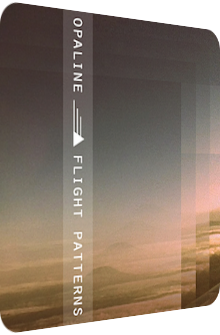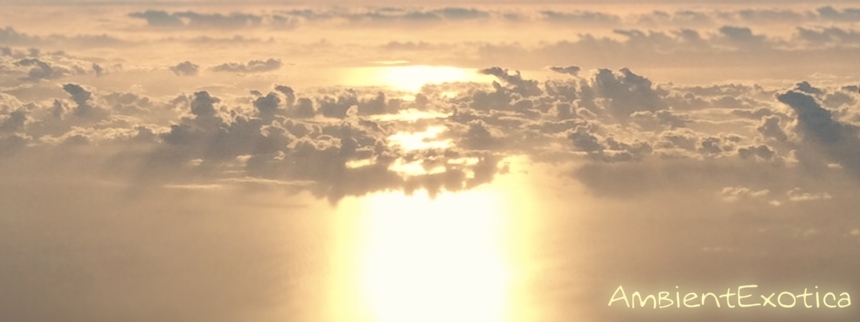
Opaline
Flight Patterns
2013
“Music for airplanes” (not -ports). This is the synopsis of Portland-based synthesist and Ambient spectrologist Hunter P. Thompson aka Opaline's four-track tape Flight Patterns, but then again, this shortest of all abstracts does hide two constituents that are at least as important. More about them in a moment. Released in December 2013 on Matthew Barlow's Twin Springs Tapes label located in Asheville, North Carolina, Flight Patterns is available to purchase and fully streamable at Bandcamp. This release is particularly synth- and Drone-driven, with spheroidal beats and whirling percussion sewn into two tracks, resulting in an even more polyhedric ambience. The quartet of compositions has been fittingly created and mixed on a flight from Portland to Los Angeles and back again, making the theme an endemic as well as an extrinsic denominator, probably akin to Celer's Climbing Formation (2013). Meanwhile, various Flight Patterns the listener shall receive, and as I have hinted at just a few seconds ago, these movements come in three gestalts: at first, they are bound to earth, as Thompson glorifies the flurry of activity in an archetypical terminal. In a second step, landmarks are shown from the very bird's eye perspective one would expect to aurally transpire in such a record. Finally, the kind of the movements as well as their physiognomies turn into transcendental motions of wonder and awe, hence going beyond the mere notion of flying. Think of the infamous finale in Stanley Kubrick's 2001: A Space Odyssey (1968), but exchange its mind-boggling scything arcana with padded susurrations in technicolor, and you come pretty close to the intrinsic factors that reign in Opaline's mildly futuristic Flight Patterns. Here is a closer look at the four tracks, the enchanting synth structures… and the conceptual dangers that come with such a work.
An aptly opalescent Ambient vignette greets the listener with its swirling synth drifts, letting him or her submerge in an immersion bath of the highest lucency and color range. Eternal Terminal (Wandering Sounds) is that opener. Its title and some of its ingredients make it earthbound, the ambientscape itself, however, is aeriform to the maximum. Semi-provincial destinations such as Düsseldorf are only architectural counterpoints to those listeners who pay attention to the female announcer's list of upcoming flights and final calls. Paying attention is hard, as several echoey voices are coated, girdled and beguiled by argentine chime patterns. They plink and glisten, contain several layers and cause a retrobulbar parallax scrolling. Swooshing stereophile airplane engines à la The Orb round off the ethereal turmoil. Eternal Terminal provides a childlike view to an ultimately dismal hub of commerce or figurative turnstile of hectic frenzy, too many people and navy blue suitcases. The field recordings ought to be unnerving due to the bustling scenery they depict, but the coruscating whirl of elation is a great – and welcome – antagonist to all pesky travel-related incidents and intricacies. And this short opener is just the beginning, for the lavishly fluffed Detroit/Drone hybrid hymn Taking Flight As The Sun Rises Over The Mountain is an enormous corker, worth the price of admission alone and a feast not only to the ears but one's existence. It sports everything I desire, which, in a probably odd operation, prevents me from analyzing it in-depth on AmbientExotica, for it has to be heard to be believed. From its wondrously dun-colored ecclesial sÿnthorama formations and their silky alloy of choir-like drones and incandescent light fractals, over the gradual shift towards even loftier yet warmer click-interspersed altitudes, to Opaline's coup de main in the shape of a beat in steady 4/4 time, this second contribution merges the millennial Microhouse motif with Detroit drones and club-compatible drums. It is aural aurum, an airy ayre.
Side B of the tape inherits – and mirrors – the structure of side A in that it contains another long-form piece of 17+ minutes and a sweet, smaller capsule of rapture. The aeronautic accolade Watching A Glowing Horizon Bend With Earth turns out to be that second long-form piece, an astutely wraithlike Drone piece sans beats. Intrinsically explicating the gigantomachy between hyper-polished airflows of celestial freshness and heliospheric helixes on the one hand, and the rustier, large-grained haze undercurrents on the other, it lets the listening subject soak in the twofold nature, but hides the dichotomy, as the layers are largely compatible with each other. The dark fir-green backdrop with its elasticized sylvan rhizomes harmonizes well with the similarly prolonged crystalline fractals and intersecting junctions. Spacious flute-like square lead pads put the finishing touches on this gem and are deeply embedded in this mélange of alloys, never protruding the similarity to a breezy plateau. What I have not mentioned thus far is the tonality. Thompson connects with Gas' eponymous debut (1996) timbre-wise, as both works share a gassy diffusion and dioramas of macro cloudlets, but Opaline's Watching A Glowing Horizon Bend With Earth is not based on comprehensible or transparent loops; it is more progressive, showcases elysian moods, arcane mysteries and a pompous majesty. Indecisive of its real nucleus and vacillating between felicity and obscurity, it lives up to the intriguing concomitance of antagonistic forces. The final piece is called Landing In An Ocean Of Light (Flight Reprise) and displays the superb conflation of echoey breakbeat shards and strikingly purified droning glaciers. More of a loop-based addendum than a fully fleshed out vignette, it is Hunter P. Thompson's easiest artifact, quickly consumable, and yet keen on absorbing the bequeathed texture-related legacy of this tape.
Flight Patterns is refreshingly self-explanatory qua its title alone, and it so happens that the Portland-based artist has to face the danger of banality. The whole world travels, that famous terminal-related 1978 work of Brian Eno is said to have kicked off the Ambient genre in a concentrated manner, and to make matters worse, the inclusion of jet engines, public service announcements and hurrying footsteps is injected in Ambient tracks all over the world right as you read this sentence. Now to the good part: Opaline outshines the prosaicness of these instances and leaves behind the airport's holy halls as he flies and floats – or better still, dematerializes – towards the evening sun, reaching a weightless transcendental form of existence. These descriptions are admittedly chintzy, I am fully aware of this, but they tend to partially hit the distinct quality of Thompson's sound-related approach. The synths are incredible, living up to both the artist's moniker and the darker interstices where the light is not refracted as shiningly. The higher spheres of his sounds glow and gleam, whereas the lower frequencies admix an oomph and winging verdure which adds, as I tend to say, plasticity to the layers. Opaline's way of piecing these titular flight patterns together is of note as well. While this is a deep, Detroit-y Drone work with frilly surfaces and an aerial feeling, Thompson does not succumb to an overly wadded thickness. It is true that the field recording-heavy opener, the beat-driven tracks 2 and 4 as well as the beatless lanthanum gas flare of the third track are highly immersive and well-texturized. But it is also true that the artist does not overegg the pudding. Even the diametrically opposite textures fit well together and augment the emotional cocktail when one is up in the air. Blessed be those who can distill the beauty of flying in an airplane as they feel the excitement and contradictory nervousness that come along with this sphere. Business travelers and sufferers from aviophobia are unfortunately left out, probably for eternity. Everyone else might be both delighted and enlightened due to Opaline's marveling viewpoint onto the subject of flying.
Further listening and reading:
- You can purchase and stream Flight Patterns at Bandcamp.
- Opaline and Twin Springs Tapes are on Twitter: @ooppaalliinnee and @TwinSpringsTps.
Ambient Review 302: Opaline – Flight Patterns (2013). Originally published on Jan. 1, 2014 at AmbientExotica.com.
